Learn more about forestry and forest health issues with these upcoming events in February and March! We link to conference brochures and webpages where you can find detailed information, including registration prices and deadlines where applicable. Continue reading “Upcoming forest health events”
Forest Health News
Oak wilt found in Forest Co. and northern townships
By forest health specialists Paul Cigan, Hayward, paul.cigan@wisconsin.gov, 715-416-4920 and Linda Williams, Woodruff, linda.williams@wisconsin.gov, 920-360-0665
Oak wilt has been found for the first time in Forest County and several new northern townships in 2019. These previously undocumented infections were detected using a combination of ground surveys, forester and landowner reports and aerial survey flights. This deadly fungal disease of red oaks has now been confirmed in 65 of Wisconsin’s 72 counties.
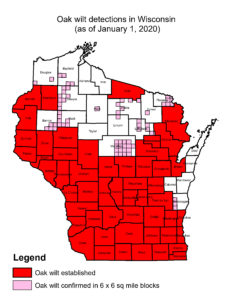
Oak wilt detection map as of January 1, 2020.
Continue reading “Oak wilt found in Forest Co. and northern townships”
Protect your trees from disease by pruning when they have no leaves
By Paul Cigan, forest health specialist, Hayward, paul.cigan@wisconsin.gov, 715-416-4920
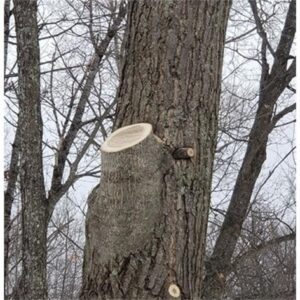 With the new year upon us, healthy lifestyle habits are sure to be on many people’s minds as they plan for changes in diet and exercise. The new year is also the perfect opportunity to make healthier choices for trees! Winter is the ideal time for tree pruning while avoiding harmful, disease-carrying pests such as the tiny beetles that carry oak wilt from one tree wound to another.
With the new year upon us, healthy lifestyle habits are sure to be on many people’s minds as they plan for changes in diet and exercise. The new year is also the perfect opportunity to make healthier choices for trees! Winter is the ideal time for tree pruning while avoiding harmful, disease-carrying pests such as the tiny beetles that carry oak wilt from one tree wound to another.
“The best time to prune trees that lose their leaves is during winter when the trees are dormant,” said DNR forest health specialist Paul Cigan. “Not only is it easier to see where pruning is needed when leaves are gone, but disease-carrying pests are inactive due to the cold, making pruning both more effective and less likely to invite unwanted pests.”
While pruning in winter reduces the risk of spread through beetles, Cigan pointed out that the disease can spread year-round in firewood. “Several recent oak wilt finds in northern Wisconsin, including a first-ever find in Forest County, may have been the result of infected firewood brought from areas with oak wilt,” Cigan said. “Keep oak firewood where it is cut for one year, or until the bark is naturally loose, to prevent the spread of oak wilt,” he advised.
For more information, visit DNR webpages for oak wilt and firewood.
Pruning tips
Yard trees and trees in urban settings should be pruned throughout their entire life to maintain strong structure and remove dead wood. Young trees should be pruned to establish a central trunk, proper trunk taper and good branch structure and spacing. Older trees should be pruned to remove dead and/or hazardous limbs. “Pruning should not remove more than 25 percent of the live tree crown, and the lower third of deciduous tree trunks should be free of limbs,” advised DNR urban forestry coordinator Don Kissinger. You can find more detailed, step-by-step tips for tree pruning in this DNR tree pruning publication.
Certified arborists who offer pruning and other tree care services can be found at waa-isa.org/arborists/search.asp.
2019 Forest Health Annual Report now available
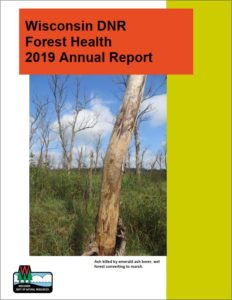
Forest health annual report now available for 2019.
The Forest Health Annual Report summarizes notable impacts for that year of pests, diseases and weather on the health of Wisconsin’s forests. The report is a collaborative product created by DNR forest health specialists from around the state. It outlines the damage and spread of both native and invasive pests and diseases during that year and puts these into context of observations from previous years. Management programs and their results are also described. Highlights from the 2019 annual report include:
- Dramatically increased decline and mortality from emerald ash borer in southern WI
- New county and township detections of oak wilt
- Precipitation record and major storm damage
- Summary of state nursery studies on Diplodia sapinea, galls on jack pine seedlings, and testing new fumigants to replace methyl bromide
This year’s annual report is available on the DNR forest health homepage. Previous annual reports, including historical reports dating back to 1951, are archived and available upon request. Contact your local forest health specialist if you’d like digital copies of any archived annual reports.
Snow fleas spring to surface in early December
By Todd Lanigan, forest health specialist, Eau Claire. todd.lanigan@wisconsin.gov; 715-210-0150
Snow fleas are a species of springtails that are active during winter and are generally found in groups where their dark-colored bodies stand out against the white snow. While often observed in late winter or early spring, they also come to the surface on warm winter days, making an early December appearance in west central Wisconsin something to note but not altogether unusual given the relatively warm weather in the area.
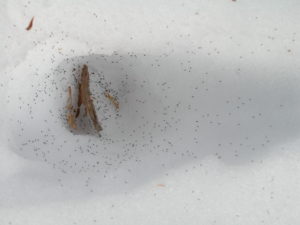
Easily mistaken for specks of dirt or debris, snow fleas are tiny soil-dwelling animals that gather on the surface of snow on warm winter and spring days.
Continue reading “Snow fleas spring to surface in early December”
New map illustrates damage from EAB
Forest health staff recently produced a map that highlights a gradient of damage from southeastern to northwestern Wisconsin, which roughly corresponds to the length of time EAB has been present in these parts of the state. Whatever the level of damage, homeowners and landowners should consider treating healthy ash, including trees that have responded well to previous treatments, or removing declining, untreated ash before they become hazardous and even more costly to remove.
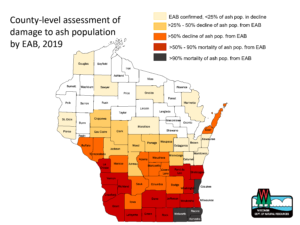
County-level assessment of damage to ash population by emerald ash borer, 2019.
Invasive plants, ticks and you
Most people are familiar with the impacts of invasive plants to natural areas, but did you know that invasive plants can be hazardous to human health? Did you also know there is a new app available to learn about tick activity near you and help researchers by recording your own tick encounters?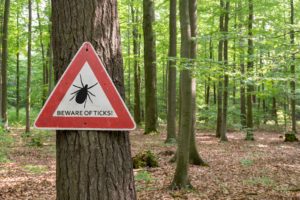 Continue reading “Invasive plants, ticks and you”
Continue reading “Invasive plants, ticks and you”
Leaf beetle spreading in southern Wisconsin
Mike Hillstrom, forest health specialist, Fitchburg, Michael.Hillstrom@wisconsin.gov, 608-513-7690
Viburnum leaf beetle is a relatively new invasive insect from Europe that feeds on the leaves of viburnums and causes mortality after a few years of repeated defoliation. Along with the killing of native viburnum species, which are highly susceptible to the pest, impacts include a higher likelihood of invasive species becoming established following the mortality. Continue reading “Leaf beetle spreading in southern Wisconsin”
Pine wood nematode in Waushara County
By Alex Feltmeyer, forest health specialist, Plover, alexandra.feltmeyer@wisconsin.gov, 715-340-3810
Pine wood nematode (PWN) was recently found to be infecting Scotch pine in Waushara County. Symptoms of pine wood nematode include rapid crown browning (within 3 months) in late summer, rapid drying of wood and presence of blue-stain fungi in the wood.
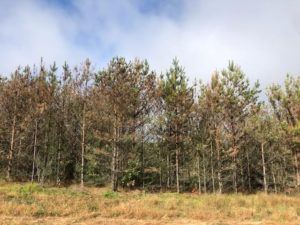
Symptomatic trees dying from pine wood nematode. Photo by Alex Feltmeyer.
Dead and dying ash are hunting hazard
By Bill McNee, forest health specialist, Bill.McNee@wisconsin.gov, 920-360-0942 and Andrea Diss-Torrance, invasive forest insects program coordinator, Andrea.DissTorrance@wisconsin.gov, 608-264-9247
Hunters should avoid placing tree stands in or near ash trees, especially in the southern half of Wisconsin, the Mississippi River region and in Door County. Many ash trees in these areas are dead or dying from attack by emerald ash borer (EAB), becoming weaker and more likely to break even with little to no added weight. Continue reading “Dead and dying ash are hunting hazard”
